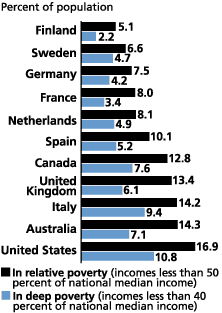
Poverty in the United States and Other Western Countries
(May 2002) It is difficult to compare poverty levels in different countries. Countries not only have different currencies, they have different family income levels, consumption patterns, prices for goods and services (which affect purchasing power), spending patterns, and family and demographic characteristics. Different countries also adopt very different criteria for setting absolute income thresholds that define poverty. As a result, most cross-national studies use relative measures of poverty as a basis for comparison.
A recent study by Timothy Smeeding, Lee Rainwater, and Gary Burtless showed striking differences in western countries’ rates of relative poverty, which they defined as 50 percent of the median adjusted disposable personal income (ADIN) for persons (adjusted for family size). They also measured deep poverty, defined as 40 percent of the median ADIN. Using data from the Luxembourg Income Study, the researchers showed that the United States has the highest relative poverty (and deep poverty) rates among those countries observed (see figure).
Relative Poverty in Selected Industrialized Countries, 1990s

Source: Luxemborg Income Study, “Key Figures: Relative Poverty Rates”
(www.lisproject.org/keyfigures/povertytable.htm, accessed April 2, 2002).
Reference
Timothy Smeeding et al., “United States Poverty in a Cross-National Context,” Focus 21, no. 3 (2001): 50-54.






